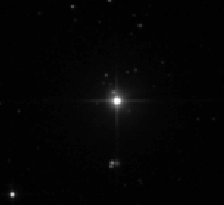
AU Microscopii is a young red dwarf star located 31.7 light-years away – about 8 times as far as the closest star after the Sun. The apparent visual magnitude of AU Microscopii is 8.73, which is too dim to be seen with the naked eye. It was given this designation because it is in the southern constellation Microscopium and is a variable star. Like β Pictoris, AU Microscopii has a circumstellar disk of dust known as a debris disk and at least two exoplanets, with the presence of an additional two planets being likely.
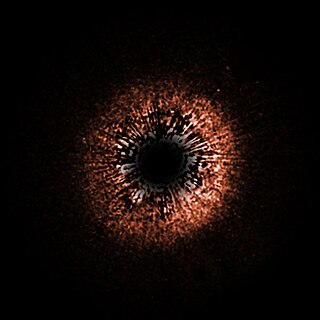
HD 107146 is a star in the constellation Coma Berenices that is located about 90 light-years (28 pc) from Earth. The apparent magnitude of 7.028 makes this star too faint to be seen with the unaided eye.
HD 210277 is a single star in the equatorial constellation of Aquarius. It has an apparent visual magnitude of 6.54, which makes it a challenge to view with the naked eye, but it is easily visible in binoculars. The star is located at a distance of 69.6 light years from the Sun based on parallax, but is drifting closer with a radial velocity of −20.9 km/s.
HD 38529 is a binary star approximately 138 light-years away in the constellation of Orion.

HD 12039, also known as DK Ceti, is a variable star in the constellation of Cetus at a distance of 135 ly (41 pc). It is categorized as a BY Draconis variable because of luminosity changes caused by surface magnetic activity coupled with rotation of the star. The stellar classification G4V is similar to the Sun, indicating this is a main sequence star that is generating energy at its core through the thermonuclear fusion of hydrogen. The effective temperature of 5,585 K gives the star a yellow hue. It has about the same mass as the Sun, but only emits 89% of the Sun's luminosity. This is a young star with age estimates ranging from 7.5−8 million years to 30 million years.

A debris disk, or debris disc, is a circumstellar disk of dust and debris in orbit around a star. Sometimes these disks contain prominent rings, as seen in the image of Fomalhaut on the right. Debris disks are found around stars with mature planetary systems, including at least one debris disk in orbit around an evolved neutron star. Debris disks can also be produced and maintained as the remnants of collisions between planetesimals, otherwise known as asteroids and comets.
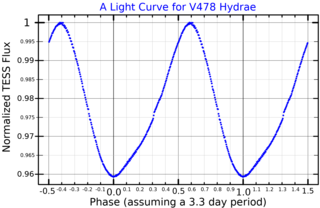
HD 70573 is a variable star in the equatorial constellation of Hydra. At a mean apparent visual magnitude of +8.7, this yellow-hued star is too dim to be visible to the naked eye. Based upon parallax measurements, it is located at a distance of 193 light years from the Sun, and is drifting further away with a radial velocity of 20.5 km/s. It is a candidate member of the proposed Hercules-Lyra Association of co-moving stars, although this membership is disputed.
HD 98800, also catalogued as TV Crateris, is a quadruple star system in the constellation of Crater. Parallax measurements made by the Hipparcos spacecraft put it at a distance of about 150 light-years away. The system is located within the TW Hydrae association (TWA), and has received the designation TWA 4.
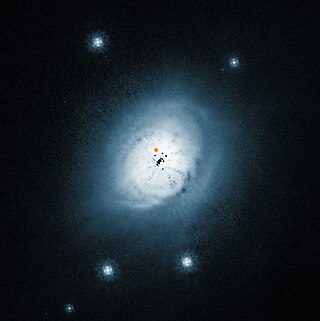
HD 100546, also known as KR Muscae, is a pre-main sequence star of spectral type B8 to A0 located 353 light-years from Earth in the southern constellation of Musca. The star is surrounded by a circumstellar disk from a distance of 0.2 to 4 AU, and again from 13 AU out to a few hundred AU, with evidence for a protoplanet forming at a distance of around 47 AU.
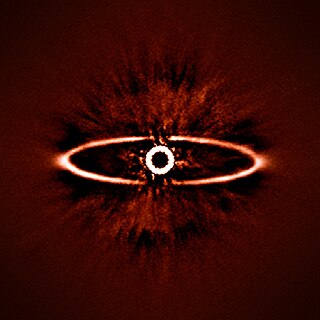
HR 4796 is a binary star system in the southern constellation of Centaurus. Parallax measurements put it at a distance of 235 light-years from the Earth. The two components of this system have an angular separation of 7.7 arcseconds, which, at their estimated distance, is equivalent to a projected separation of about 560 Astronomical Units (AU), or 560 times the separation of the Earth from the Sun. The star and its ring resemble an eye, and it is sometimes known by the nickname "Sauron's Eye".
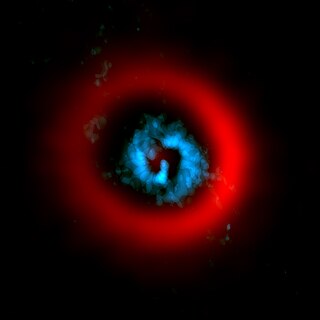
AB Aurigae is a young Herbig Ae star in the Auriga constellation. It is located at a distance of approximately 531 light years from the Sun based on stellar parallax. This pre-main-sequence star has a stellar classification of A0Ve, matching an A-type main-sequence star with emission lines in the spectrum. It has 2.4 times the mass of the Sun and is radiating 38 times the Sun's luminosity from its photosphere at an effective temperature of 9,772 K. The radio emission from the system suggests the presence of a thermal jet originating from the star with a velocity of 300 km s−1. This is causing an estimated mass loss of 1.7×10−8 M☉ yr−1.

HD 92945 is a K-type main sequence star in the constellation of Hydra. Its apparent visual magnitude varies by 0.02 magnitudes and is approximately 7.72 at maximum brightness.

HD 139664 is a single star in the southern constellation of Lupus. It has the Bayer designation g Lupi; HD 139664 is the star's identifier from the Henry Draper Catalogue. It has a yellow-white hue and is visible to the naked eye with an apparent visual magnitude of 4.64. The star is located at a distance of 57 light years from the Sun based on parallax, and it is drifting closer with a radial velocity of −7 km/s. It is a member of the Hercules-Lyra Association of co-moving stars.
HD 202628 is a single star in the southern constellation of Microscopium. It has an apparent visual magnitude of +6.7, which makes it too faint to be readily visible to the naked eye. The star is located at a distance of 77.7 light years from the Sun based on parallax, and it is drifting further away with a radial velocity of +12.1 km/s. The absolute magnitude of this star is 4.86.

Nu Horologii, Latinized from ν Horologii, is the Bayer designation for a single star in the southern constellation of Horologium. It was catalogued by the Dutch explorer Frederick de Houtman in 1603. With an apparent visual magnitude of 5.3, this star can be seen with the naked eye from the southern hemisphere. Based upon parallax, Nu Horologii lies at a distance of 169 light-years from Earth. It is drifting closer to the Sun with a radial velocity of +31 km/s.
HD 215152 is the Henry Draper Catalogue designation for a star in the zodiac constellation of Aquarius. It has an apparent visual magnitude of 8.13, meaning it is too faint to be seen with the naked eye. Parallax measurements provide distance estimates of around 70 light years. The star has a relatively high proper motion, moving across the sky at an estimated 0.328 arc seconds per year along a position angle of 205°.
HD 219623 is a solitary star in the northern circumpolar constellation of Cassiopeia. HD 219623 is its Henry Draper Catalogue designation. It has an apparent visual magnitude of 5.59, which lies in the brightness range that is visible to the naked eye. According to the Bortle scale, it can be observed from dark suburban skies. Parallax measurements place it at an estimated distance of around 67.2 light years. It has a relatively high proper motion, advancing 262 mas per year across the celestial sphere.

PDS 70 is a very young T Tauri star in the constellation Centaurus. Located 370 light-years from Earth, it has a mass of 0.76 M☉ and is approximately 5.4 million years old. The star has a protoplanetary disk containing two nascent exoplanets, named PDS 70b and PDS 70c, which have been directly imaged by the European Southern Observatory's Very Large Telescope. PDS 70b was the first confirmed protoplanet to be directly imaged.

AK Scorpii is a Herbig Ae/Be star and spectroscopic binary star about 459 light-years distant in the constellation Scorpius. The star belongs to the nearby Upper Centaurus–Lupus star-forming region and the star is actively accreting material. The binary is surrounded by a circumbinary disk that was imaged with VLT/SPHERE in scattered light and with ALMA.

CQ Tauri is a young variable star in the equatorial constellation of Taurus. It is too faint to be visible to the naked eye with an apparent visual magnitude that ranges from 8.7 to 12.25. The distance to this star is approximately 487 light years based on parallax measurements, and it is drifting further away with a radial velocity of ~23 km/s. It appears to be part of the T-association Tau 4. CQ Tauri lies close enough to the ecliptic to undergo lunar occultations.














